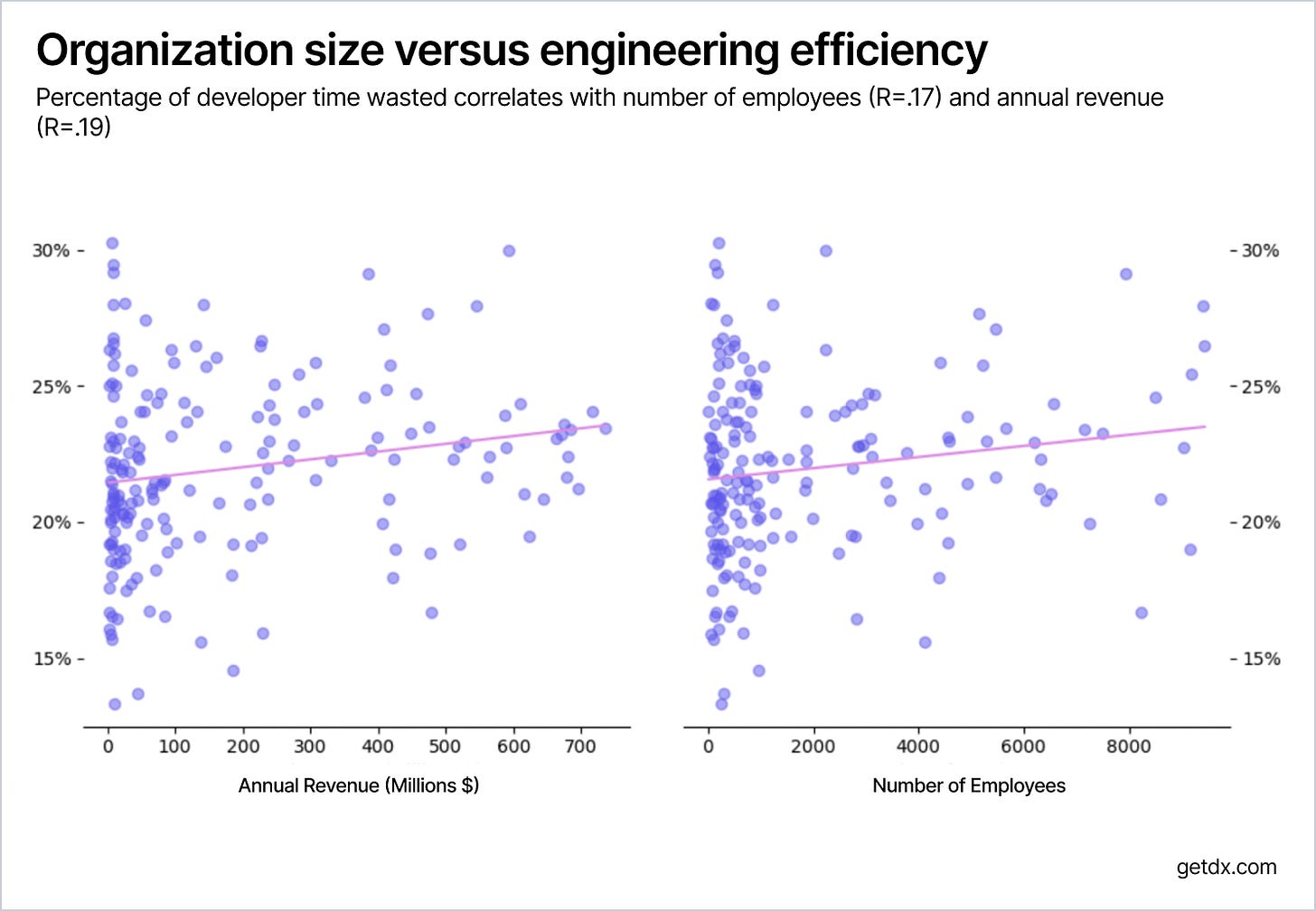How (in)efficient are engineering organizations?
On average, developers lose 22% of their time to obstacles or inefficiencies in their work environment.
This is the latest issue of Engineering Enablement, a weekly newsletter covering the data behind world-class engineering organizations. To get articles like this in your inbox every Friday, subscribe:
At DX, we’re constantly meeting with engineering leaders who want their engineering organizations to operate more efficiently, and we see that it’s a topic that’s difficult for leaders to quantify and understand.
Tightened fiscal conditions and sweet promises of generative AI have pushed the conversation to a boiling point, with boardrooms and CEOs demanding “better and faster” from their software engineering teams like never before.
We wanted to understand what “efficiency” really looks like, so we dug into aggregate data from DX to explore. DX helps organizations measure efficiency in terms of time wasted using validated survey items. We took a sample of 30,000 recent developer responses from 180 organizations and analyzed the data for trends.
Efficiency is calculated as the percent of developers’ time that is lost due to obstacles or inefficiencies in their work environment. This includes factors that come solely from people (collaboration and planning), purely from systems (automated builds or tests), and from people but mediated through systems (code review process).
On average, engineers report 22% of their time being wasted. The average organization's inefficiency (interpreted as their average developer response) is nearly identical. We also found that the distribution of variation in team efficiency in organizations has a long tail, meaning that within several companies, some teams are much more efficient than others.
These are staggering numbers! Translated into dollars, these numbers mean that nearly a quarter of a developer's salary is utilized toward non-accretive tasks. Assuming an average fully-loaded cost of $250,000 per developer, the total value wasted equates to a considerable $1.55 billion of potential productivity lost to inefficiency.
These numbers highlight an enormous opportunity for organizations to improve efficiency by eliminating areas of friction in order to recapture significant engineering capacity.
It is also interesting to consider how much of this waste may constitute low-hanging opportunities for improvement and harder gains, as opposed to some kind of "efficiency floor". After all, no organization or developer can operate without some amount of inefficiency. Further research is needed to investigate this within the software development lifecycle.
As we analyzed our data, there was another question we were interested in: what's the relationship between an organization's size and its efficiency? People often talk about how larger organizations are slower and less efficient than smaller ones, but is this true in reality, or is it just a myth?
Our analysis found that developer time wasted does correlate with an increase in the number of employees (R=.17) and revenue (R=.19). The similarity of these two relationships is unsurprising, since employee count and revenue correlate strongly (R=.63). This suggests a need for continuous improvement in both small and large engineering orgs to maximize engineering productivity and business outcomes.
This data lends support to the widely held belief that larger organizations are less efficient in terms of speed of software delivery and overall engineering efficiency. The critical question now becomes: What separates the large organizations that manage to retain efficiency, from those that struggle to keep pace? Identifying the key factors that enable some to excel where others lag may offer helpful insights for organizations striving to scale without sacrificing their operational efficiency and deployment processes.
At DX, we have amassed a trove of data from hundreds of thousands of developers across organizations worldwide. We’ll dive into these questions and more in upcoming articles – next up, we will be looking into data around the efficiencies of “Tech” vs “Traditional” companies, and discover what we have to learn about their development processes and deployment practices.
For full descriptive statistics and additional visualizations, you can download the report.
Who’s hiring right now
Find Developer Experience job openings on this job board.
Thanks for reading. If you know someone who might like this issue, consider sharing it with them:
-Abi




It's much worse than that. Plenty of developers work on initiatives that get canceled, fail, or are only marginally successful (enough to incur ongoing support work but not really enough to make their organizations more successful). I would guess that most of that waste isn't reflected in these survey responses. Some of it is inevitable since we can't see the future, but some of it is due to lack of care in prioritizing initiatives or poor execution (perhaps the initiative would have gone through if it had moved faster or produced better results).